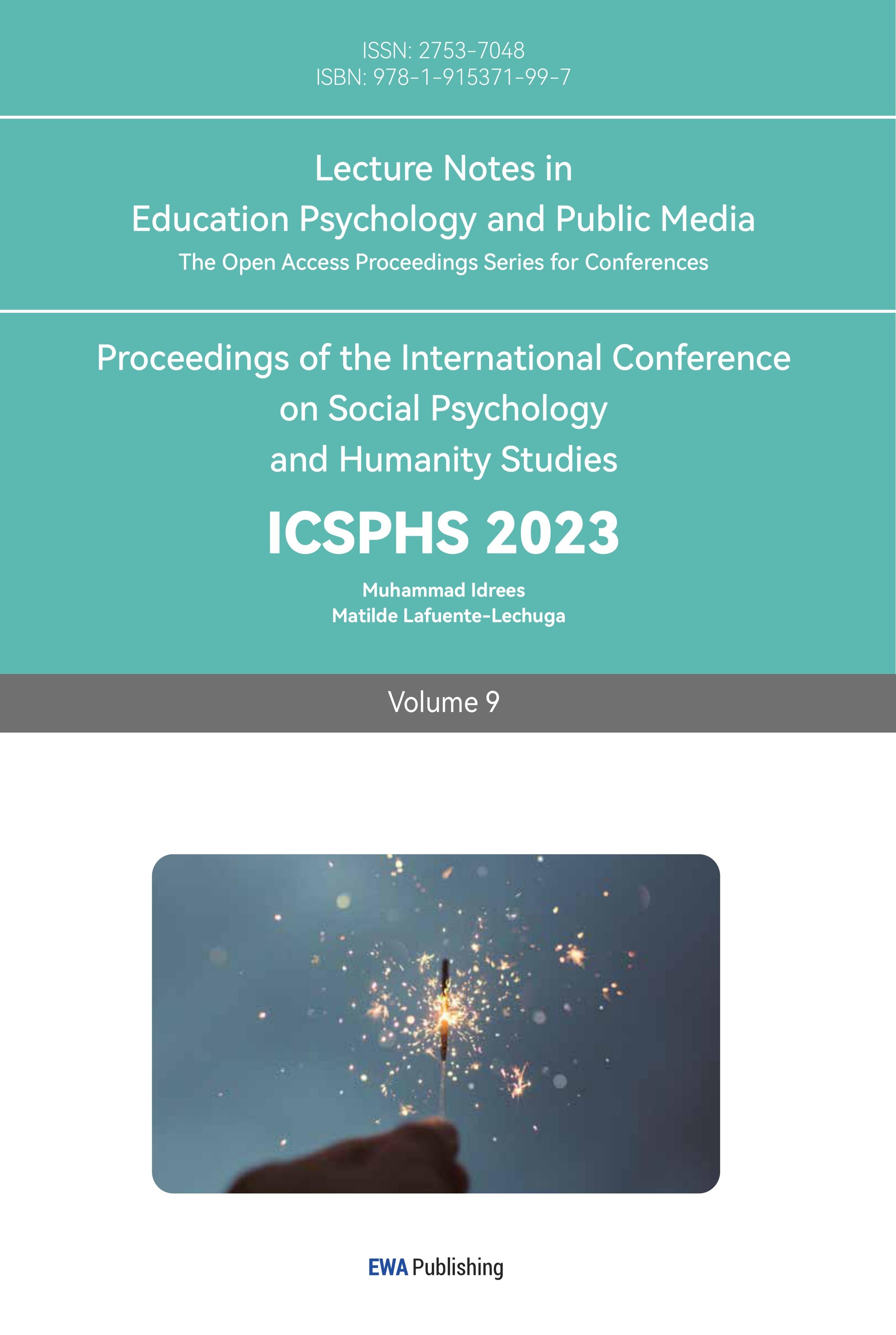References
[1]. Habron, John, and Liesl Van der Merwe. A conceptual study of spirituality in selected writings of Émile Jaques-Dalcroze. Inter. J. Mus. Edu. 2017, 35.2 175-188.
[2]. Cheng K H, Tang K Y, Tsai C. The mainstream and extension of contemporary virtual reality education research: Insights from a co-citation network analysis (2015–2020), Edu. Tech. Res. Dev., 2022, 70(1): 169-184.
[3]. Limniou M, oberts D, apadopoulos N. Full immersive virtual environment CAVETM in chemistry education. Com. Edu., 2008, 51(2), 584-593.
[4]. Chan J. C. P., Leung H., Tang J. K. T., et al. A Virtual Reality Dance Training System Using Motion Capture Technology. IEEE Trans. Learn. Tech., 2011,4(2), 187-195.
[5]. Krevelen Rick Van, Poelman Ronald. A Survey of Augmented Reality Technologies, Applications and Limitations. Vir. Real., 2010, 9(1), 10-23.
[6]. Su C., Han Z., A review of application cases of augmented reality (AR) in teaching, China Audio Vis. Edu., 2017, (3), 1-9.
[7]. Kuhlo M, Kuhlo M. Architectural rendering with 3ds Mex and V-Ray, Photo. Vis., 2013, 62(2), 41-49.
[8]. Chen H, Feng K, Mo C, Application of augmented reality technology in college maker education, China Audio Vis. Edu.,2016, (10): 112-115.
[9]. Tao J, He Q, Na Z, et al. Exploring Virtual Display Design based on 3DSMAX and VR-Platform, IEEE Inter. Conf. Com. Ind. Des. Con. Des. 2010, 1-10.
[10]. Ling Z, Personalized healthcare museum exhibition system design based on VR and deep learning driven multimedia and multimodal sensing, Per. Ubi. Com, 2022, 198-207.
Cite this article
Li,B.;Wang,Y.;Zhang,C. (2023). Research and Analysis of VR Technology in the Field of Education. Lecture Notes in Education Psychology and Public Media,9,32-38.
Data availability
The datasets used and/or analyzed during the current study will be available from the authors upon reasonable request.
Disclaimer/Publisher's Note
The statements, opinions and data contained in all publications are solely those of the individual author(s) and contributor(s) and not of EWA Publishing and/or the editor(s). EWA Publishing and/or the editor(s) disclaim responsibility for any injury to people or property resulting from any ideas, methods, instructions or products referred to in the content.
About volume
Volume title: Proceedings of the International Conference on Social Psychology and Humanity Studies
© 2024 by the author(s). Licensee EWA Publishing, Oxford, UK. This article is an open access article distributed under the terms and
conditions of the Creative Commons Attribution (CC BY) license. Authors who
publish this series agree to the following terms:
1. Authors retain copyright and grant the series right of first publication with the work simultaneously licensed under a Creative Commons
Attribution License that allows others to share the work with an acknowledgment of the work's authorship and initial publication in this
series.
2. Authors are able to enter into separate, additional contractual arrangements for the non-exclusive distribution of the series's published
version of the work (e.g., post it to an institutional repository or publish it in a book), with an acknowledgment of its initial
publication in this series.
3. Authors are permitted and encouraged to post their work online (e.g., in institutional repositories or on their website) prior to and
during the submission process, as it can lead to productive exchanges, as well as earlier and greater citation of published work (See
Open access policy for details).
References
[1]. Habron, John, and Liesl Van der Merwe. A conceptual study of spirituality in selected writings of Émile Jaques-Dalcroze. Inter. J. Mus. Edu. 2017, 35.2 175-188.
[2]. Cheng K H, Tang K Y, Tsai C. The mainstream and extension of contemporary virtual reality education research: Insights from a co-citation network analysis (2015–2020), Edu. Tech. Res. Dev., 2022, 70(1): 169-184.
[3]. Limniou M, oberts D, apadopoulos N. Full immersive virtual environment CAVETM in chemistry education. Com. Edu., 2008, 51(2), 584-593.
[4]. Chan J. C. P., Leung H., Tang J. K. T., et al. A Virtual Reality Dance Training System Using Motion Capture Technology. IEEE Trans. Learn. Tech., 2011,4(2), 187-195.
[5]. Krevelen Rick Van, Poelman Ronald. A Survey of Augmented Reality Technologies, Applications and Limitations. Vir. Real., 2010, 9(1), 10-23.
[6]. Su C., Han Z., A review of application cases of augmented reality (AR) in teaching, China Audio Vis. Edu., 2017, (3), 1-9.
[7]. Kuhlo M, Kuhlo M. Architectural rendering with 3ds Mex and V-Ray, Photo. Vis., 2013, 62(2), 41-49.
[8]. Chen H, Feng K, Mo C, Application of augmented reality technology in college maker education, China Audio Vis. Edu.,2016, (10): 112-115.
[9]. Tao J, He Q, Na Z, et al. Exploring Virtual Display Design based on 3DSMAX and VR-Platform, IEEE Inter. Conf. Com. Ind. Des. Con. Des. 2010, 1-10.
[10]. Ling Z, Personalized healthcare museum exhibition system design based on VR and deep learning driven multimedia and multimodal sensing, Per. Ubi. Com, 2022, 198-207.









